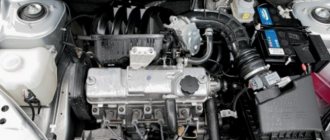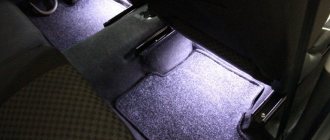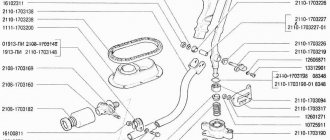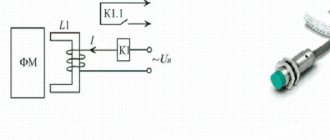Content
- "Priora" or "Kalina": classification problems
- "Kalina" or "Priora": what about the equipment?
- Motors and transmissions
- So which is better in the end - Kalina or Priora?
- Condition and choice of Lada Priora and Lada Kalina
At first glance, the question sounds like “do you want black or green tea?” On the second one, actually, too. Before the arrival of foreign engineers and managers, VAZ riveted surprisingly identical cars, even if they formally belonged to different classes.
On the secondary market, the second Kalina and the first generation restyled Priora cost almost the same - 314 and 312 thousand rubles, respectively. Offers for them are also almost at the same level - 140-155, but Priora is most often bought and sold. In May, it was checked 22,730 times through avtocod.ru, placing it in second place among all models. “Kalina” ended up in 16th place with 12,997 checks. What is better to buy on the secondary market - Priora or Kalina, let's figure it out.
Available configurations
You can find three variants of each vehicle (sedan, hatchback and station wagon). True, new Kalina sedans are no longer produced, but there are quite a lot of them on the secondary market, so there shouldn’t be any problems here.
The Priora is also available in a coupe body, but there are not so many such examples. Each car is available in one of three trim levels.
- standard. Here you will see only everything you need, there are no frills. Among the main elements, it is worth highlighting the presence of front electric windows, original bumpers, an anti-theft alarm and a remote-controlled lock. This option comes with a 1.6-liter power unit producing 81 horsepower. Price – about 280 thousand rubles;
- norm. Here you can already find anti-lock braking and climate control systems, as well as power steering and a number of small parts, such as a mirror in the passenger visor. 1.4 liter engine (89 horses). Cost – from 325 thousand. There is also an external difference - the wheels have increased to 14 inches;
- Luxury For an amount of just over 350 thousand you will receive airbags for the driver and front seat passenger, velor interior, headrests for rear passengers, electric drive and heated side mirrors. The car will also delight its owners with a number of useful functions, such as heated seats, electric lifts for all windows, fog lights, etc. The model has a 1.6-liter power unit with a capacity of 98 horsepower.
Below is a video with a test drive of the Lada Kalina:
- standard. Here the airbag comes as standard. In addition, there is also the option of a remote trunk lock, power windows at the front, and an alarm system. Not too much, but better than Kalina's. True, the eight-valve 1.6-liter engine with 90 horses does not inspire much admiration. Price – from 320 thousand;
- norm. It will cost from 325 thousand. Comes with a 16-valve engine (volume 1.6 liters, power - 98 horses). It is distinguished by the presence of a built-in anti-lock braking system, velor interior, power steering, electric drive and seat heating option. There are as many as 7 modifications of this configuration. The most expensive model has standard navigation, a good audio system and electric power steering;
- lux. Here you can see an anti-lock braking system, parking sensors, climate control, heated seats, electric windows, etc. The cost reaches almost 410 thousand rubles. In principle, the equipment is quite good, but the price is quite high.
If you choose which is better: Kalina or Priora, then the choice definitely falls on the first option. At the same cost, the configuration of this car is somewhat ahead of its main competitor.
"Priora" or "Kalina": classification problems
The word “problem” will generally accompany us throughout the text, and it begins already when determining what is in front of us.
Formally, Kalina is a European B-class, Priora is closer to a C-class. In fact, the difference in dimensions is nominal:
- top-end Kalina station wagon - 4.11 m in length;
- Priora with the same body type - 4.21 m.
At the same time, it is absolutely unclear where the extra decimeter of space went.
In terms of the amount of space in the cabin, it is also unclear which class is which: low seating, minimal gap between the rows of seats - in both cars only short and hardy people can sit in the back for a long time. That is, Mongolian steppe riders.
And it’s even funnier that in both Kalina and Priora, the body type has almost no effect on anything. It’s usually the same: a sedan has a spacious, but most inconvenient trunk, a station wagon is the opposite: it has the maximum displacement and ease of use.
What about LADA? The trunk of a station wagon is not the most spacious, but the most spacious is that of the Granta co-platform liftback (after restyling, this became one family, which makes it even funnier).
The Priora has no difference at all in terms of practicality between body types: both the liftback and the station wagon have 360 liters each behind the rear sofa.
In short, the difference is purely aesthetic. There is no point in looking for a “Kalina station wagon” or a “Priora station wagon” in the hope of seeing space and capacity there.
Also read: Focus on Priora or priority on Accent? Comparing two budget bestsellers
Lada Kalina is a good car
The model is ahead of its competitors in this price range in many respects. Specialists from the Tolyatti plant worked on this project for 10 years. Mass production was launched only in 2004. At first, Kalina could only be purchased as a standard sedan. Now, within the same line, models such as a sedan, hatchback, station wagon and sports version have appeared. In order for the comparison of the two flagships of the Russian automobile industry to be complete, it is necessary to consider the possible configurations of the Kalina.
The standard Lada Kalina, as befits a junior category, has no frills. Only the essentials are present:
- electric front windows;
- bumpers painted to match the body color;
- signaling.
The engine is inferior even to the Priora in the same design. It has another 9 horsepower less. Looking at how this particular model turned out, you understand that a car is not a luxury, but a means of transportation. The only thing that can please us is the affordable price – $8,600.
"Kalina" or "Priora": what about the equipment?
Until the second half of the 2000s it was very bad. AvtoVAZ is slow to introduce innovations, so their cars reached more or less European levels (early 90s) only in 2013. It was then that both Kalina and Priora received (all or separately) airbags, ESP, heated windows, air conditioning, automatic transmission (Kalina), a media system with navigation and support for SD cards.
Everything before 2013 is pain, poverty and mud: the list of options included ESD (periodically jamming) and ABS.
The restyling of the 13th year also had a positive effect on the visual component: the plastics are still just as cheap, but at least the parts are neat; The climate control unit, for example, has become similar to a Volkswagen one from the early 2000s. Which is actually a compliment.
So it doesn’t matter what to watch - Kalina or Priora, as long as it’s after the 2013 release.
Also read: Which is better: “Granta” or “Kalina 2”
Comfort level
If you choose Priora or Kalina based on comfort indicators, then there is no definite leader. Despite the fact that Kalina looks very compact, the inside of this car is quite spacious.
In addition, there is a slightly higher seating position and increased visibility for the driver. Enlarged rear view mirrors also add convenience. In all other respects, the cars are identical in terms of comfort.
Motors and transmissions
You shouldn’t expect variety from VAZ - this is not an Audi, they didn’t deliver a range of engines. In both cases, the choice comes down to different variations of the 1.6-liter unit: 8- or 16-valve with output of 87, 98 or 106 hp. With.
There are nuances in the boxes. Thus, Kalina and Granta were equipped with an old but honest four-band automatic transmission from the Japanese Jatco. It was combined only with the 98-horsepower version of the engine. Unlike the VAZ AMT on the Kalina and Priora, it was combined only with the top-end 106-horsepower engine.
Which, however, is obvious: a car with a “robot” doesn’t drive very well anyway, here at least you can compensate for delays and interruptions in the power flow with the maximum possible number of “horses”.
And in general, the “robot” is suitable for leisurely and picky people: shifts are long, the ride is not smooth. It is not surprising that AMT accounted for not even a third of sales of the new Kalin and Prior.
But Priora buyers have no alternative: the automatic machine belongs to the Kalina/Granta family, and it is good, minus a couple of nuances. Firstly, the dynamics with automatic transmission are very conditional (0-100 in 13.1 seconds); secondly, fuel efficiency (urban cycle - more than 10 liters per 100 km). But the comfort of movement, especially in traffic jams, is incomparably greater.
Also read: Battle of the weakest: Datsun on-DO vs Lada Granta
Road stability, power and practicality
VAZ Priora weighs 1088 kg. She can field a more powerful and faster engine against Kalina. The car is 2 cm lower than Kalina, while being almost 20 cm longer. It has a smaller mirror but a wider wheelbase. This difference in weight, shape and dimensions makes the Priora much more stable on the track. At high speed it moves quite confidently. The slightly elongated, streamlined shape gives the Priora more aerodynamics.
Viburnum is 1.5 m in height, its shape is more conducive to air resistance. When turning at speeds above 50 km/h, there is a high risk of overturning or flying into a ditch. Viburnum is lighter, so at high speed it is stormy and thrown from side to side. It is not suitable for such loads.
In the battle between Priora and Kalina, in terms of practicality, the latter wins a crushing victory. In urban mode, the real fuel consumption of Kalina 2 or the previous modification is 7.8 liters per 100 km. As for the Lada Priora, its appetite is noticeably greater; it consumes almost 9 liters per 100 km.
The question of which is more maneuverable - Lada Kalina or Lada Priora, can be answered without getting behind the wheel of either of these cars. The compact Kalina makes it easier to park or turn around in tight spaces. Its turning radius is smaller than that of the Priora or Lada 2107, as well as any other domestic car, not counting the Oka, of course.
Priora can only compete in terms of trunk size. Its volume varies in the range of 426-734 liters. In this regard, Kalina has nothing to brag about. The luggage compartment volume is only from 350 to 650 liters. The Kalina station wagon is less spacious even with the seats folded down.
The clearance of the Priora is only 165 mm, while the mobile Kalina has as much as 185 mm. Ground clearance plays an important role. These 20 cm have repeatedly proven their importance. Where Kalina passes, Priora sits on the bottom.
Under the hood of Priora
Under the hood of the Priora there is much more power than other VAZ passenger cars. It can produce 110 hp. s., although the technical passport indicates only 96 liters. With. According to manufacturers, this is done in order to reduce transport tax for the consumer. Of course, VAZ made sure that the restyled version of the Lada Kalina had a more powerful engine. The technical specifications state as much as 106 hp. With. But all this had a slight effect on the agility of the engine.
Priora accelerates to 100 km/h in 11.5 seconds, and Kalina will need as much as 14 seconds. Some Lada Kalina cars are equipped with engines identical to those of Priora. But in practice, the car does not have the power capabilities that the Priora has. The latter's carrying capacity is also much greater, but passenger cars are not designed to carry piles of bags of cement, so this indicator is not so important. But if you choose which car is more powerful, Kalina 2 or Priora, then definitely Priora.
So which is better in the end - Kalina or Priora?
A direct comparison of the Lada Priora and the Lada Kalina shows that there is nothing special to compare. Before us are two budget front-wheel drive vehicles, rooted in the design of the “eight” and “tens”. They are nominally different in size, do not differ at all in internal volumes, largely overlap in terms of equipment, and only the “two-pedal” versions are truly different.
There is an opinion that Priora is more aerobatic and sharper. At the same time, it is Kalina that is most often used as a blank for rally and race cars. Priora also seems to look more “boyish”, especially with pneuma and xenon. But these are matters of taste and internal tolerances, not technology and design.
For the average consumer with a couple of hundred thousand in his pocket, Kalina and Priora are all the same. We look at where the condition is better, then we take it.
Also read: My first car: comparison of Granta, Logan and Nexia
What to choose
When asking the question of which is better: Priora or Kalina, we can only say with confidence that both vehicles require improvement in order to successfully compete with budget foreign cars like the Kia Rio.
At the same time, if you choose between these two cars, then Kalina shows slightly better performance. It wins a little in maneuverability and efficiency.
If we talk about Priora, then this vehicle is more maneuverable and safer in terms of crash tests. True, it is more expensive, so most people still prefer Kalina.











